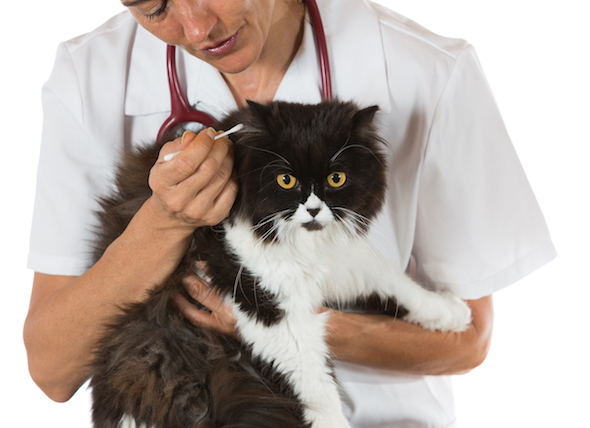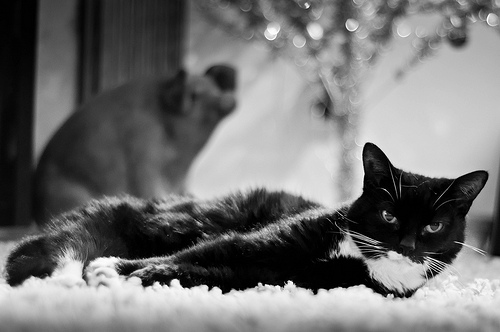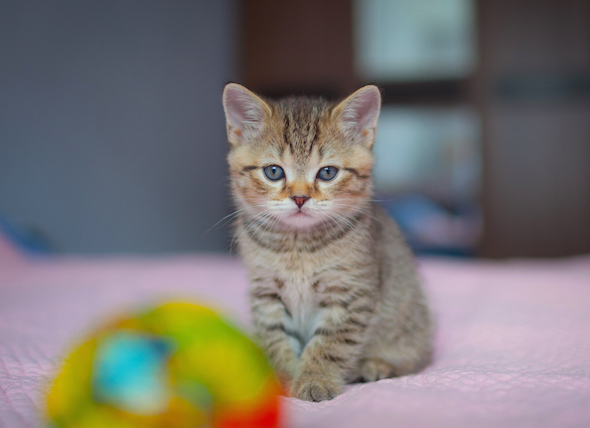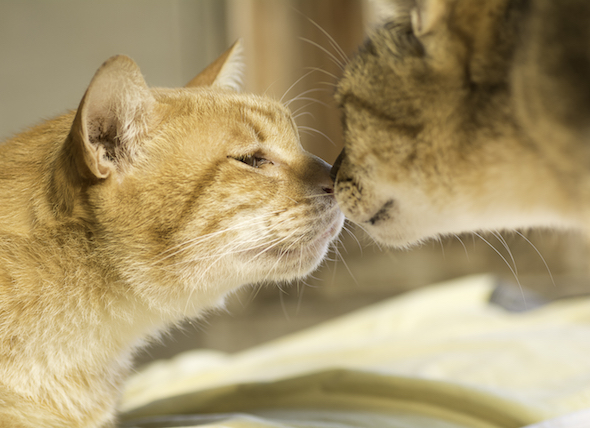

By Jennifer Kvamme, DVM
When springtime brings warm weather, you may be visited by some uninvited guests. Fleas become most active when temperatures are favorable (35°C and a relative humidity of 70 percent are ideal conditions for flea populations). In parts of the world where winter temperatures fall below this for more than 40 hours per month, households and pets get a bit of a break from flea activity.
Fleas are indeed very active insects, feeding on blood from your cat and you. They jump onto passing animals and burrow down into the fur to the skin, where they stay well hidden while biting and ingesting blood. This is irritating to the animal, and humans as well, as the bites can cause severe itching and inflammation.
In severe infestations, it’s easy to spot fleas jumping and moving on and off your cat’s body. In less obvious situations, you may notice that your cat is restless and doing more scratching or chewing on certain areas of his body. Shaking the head often and scratching at the ears is another indication of a possible flea infestation in your cat.
Excessive and constant licking at the haircoat is another sign of potential fleas, especially in cats. Many cats will even groom the fleas out of the haircoat before you get a chance to see the evidence.
In order to see actual fleas on your pet, you may have to look fast. Fleas can jump very fast and very high. Fleas are very small (1/16-1/8 in.), flat-bodied insects that are a dark brown, almost black, color. The more blood they ingest the lighter in color they may appear.
Turn your cat on his back and check areas that allow fleas to hide. The armpits and groin are two areas that are warm and protected; favored spots for fleas to hide out. Check your cat’s ears carefully for signs of scratching, redness, blood, or dirt. These can all be signs of fleas. The skin on the belly, groin, or base of the tail may appear red and bumpy, especially if your cat is doing a lot of scratching. Hair loss may occur in certain areas that are being scratched excessively, and there may be black spots on the skin along with scabbing.
Get a flea comb (a specially made comb with closely set teeth) and run it through the hair on your cat’s back and legs. The comb’s teeth are designed to catch and pull fleas out from under the haircoat where they are hiding. Make sure you get close to the skin when running the comb through the hair so you have a greater chance of getting to where the fleas are hiding out. Have a bowl of soapy water on hand to douse any live fleas into as you find them while combing.
One trick that may help you if the fleas are hard to see is to place a white piece of paper or paper towel on the floor next to your pet while coming through his hair. Flea dirt (i.e., flea feces) will fall off of the cat’s skin and land on the paper. One way to differentiate between regular dirt and flea "dirt" is to wet any black specks that fall off the cat onto the white paper towel (using regular water sprinkled on the specks). If they turn a dark reddish-brown color, you are seeing the digested blood that the flea has passed through its body and excreted.
Fleas don’t just stay on your cat. They can also be found throughout the house and in areas where your cat spends a lot of his time. Closely examine your cat’s feeding area, bedding, and other favorite locations for signs of flea dirt (black specks), or for the fleas themselves. As you know, cats like to sleep on top of things like the window sills, kitchen cabinets and refrigerator, so be sure to get up high when examining their favorite haunts.
Another method to search for flea dirt in the house is to wear white socks and walk through areas frequented by your pet. Fleas and/or flea dirt may be picked up by the fibers of the socks and will stand out on the white background.
A "light trap" may also help detect the presence of fleas in the household. At night, before turning off all the lights for the night, set a small bowl of water with dishwashing soap near a nightlight on the floor. Fleas will tend to jump toward the light and will fall into the bowl, where they will drown. In the morning, you may find several floating in the water.
If you can’t find any signs of actual fleas on your cat or in the environment, or if you have done the full flea eradication treatment on your cat and home but your cat is still scratching, it’s time to get advice from your veterinarian. He or she will help you determine the cause of your cat’s discomfort and suggest treatment options.
 How Gene Research Can Help Your Cat Lose Weight
By Jennifer Coates, DVM
It's easy
How Gene Research Can Help Your Cat Lose Weight
By Jennifer Coates, DVM
It's easy
 How to Clean a Cat’s Ears
By Elizabeth Xu
Your
How to Clean a Cat’s Ears
By Elizabeth Xu
Your
 Holistic Medicine and How it Can Help Your Pet
By Yahaira Cespedes
Keeping Your Pet He
Holistic Medicine and How it Can Help Your Pet
By Yahaira Cespedes
Keeping Your Pet He
 Cat Facts: How Long Are Cats In Heat
By Helen Anne Travis
With millio
Cat Facts: How Long Are Cats In Heat
By Helen Anne Travis
With millio
 How to Introduce Cats
By Lynne Miller
If your cat used
How to Introduce Cats
By Lynne Miller
If your cat used
Copyright © 2005-2016 Pet Information All Rights Reserved
Contact us: www162date@outlook.com